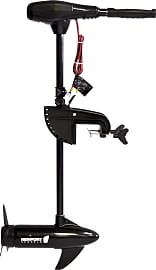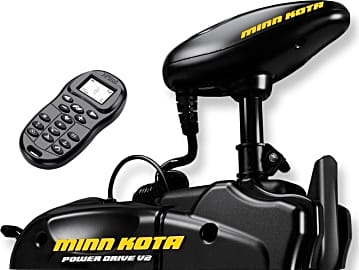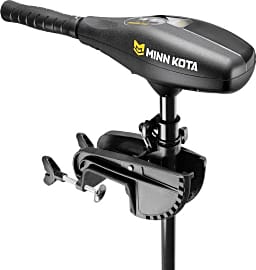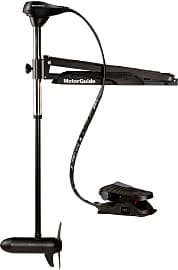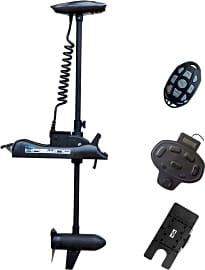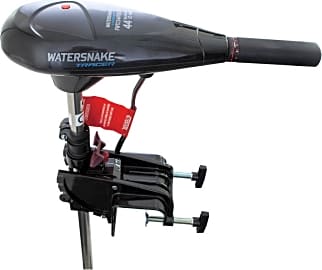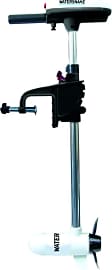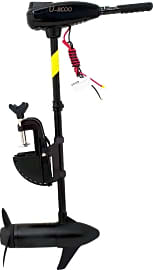The 10 Best Trolling Motors

This wiki has been updated 41 times since it was first published in April of 2015. These trolling motors will enable you to drag your lure at the ideal speed to entice fish out of their underwater hiding places and, hopefully, into your boat. Most of these models are suitable for both fresh and saltwater environments and offer bow or transom mounting on kayaks, canoes, and dinghies. Unlike gas-powered models, they don't produce much noise or any mess. When users buy our independently chosen editorial picks, we may earn commissions to help fund the Wiki.
Editor's Notes
October 22, 2020:
Nearly all the motors in our list are either fairly new models such as the Watersnake ASP and the Newport Vessels Electric, or are older models that are popular and deserve their place in the list like the MotorGuide X3, which is well thought of in the angling community.
The Haswing Black Cayman 12V was an easy addition due to its obvious quality, added to the fact that it has a wireless remote control and a footswitch for steering when you have your hands full fighting a decent-sized fish. The ability to swing the boat's bow around with just your feet is invaluable when trying to land a bite.
We added the U-BCOO 8 Speed as it is obviously popular and exceptionally good value. It comes with features that many other, pricier engines are lacking, the only downside being shorter battery life.
April 13, 2019:
By all accounts, the Newport Vessels NV-Series is a high-quality choice, as users have reported impressive performance in a range of conditions in both saltwater and freshwater environments.
Eliminated the Motorguide R3 due to numerous complaints about a short life. Some users experienced gradually deteriorating performance before the motor quit completely. Consistently positive reports on the Minn Kota Endura C2 led us to move it up on the list. Users express satisfaction regarding its smooth handling at all speeds, extremely impressive battery life, and quiet operation. It also comes in three sizes and six power levels, allowing users to choose the style that best fits the boat they’ll be using and the fishing approach they'd like to employ.
Added the Newport Vessels Electric as a quality blend between value and versatility. For a relatively low cost, it provides reliable power, an adjustable shaft, and eight speeds (three forward, three reverse), so there’s virtually no limit to the styles of approach fishermen can use with this model. We also wanted to provide another high-end model, which we did in the Minn Kota Power Drive. Users report satisfaction in both its power and precision, and it includes a remote for controlling the motor from anywhere in the boat.
Trolling For Fish: The Basics
Trolling is the preferred fishing style of many recreational fishers, who find the activity both relaxing and rewarding.
Just to be clear from the get-go, trolling is a style of fishing wherein a baited fishing line (or sometimes several lines) are drawn along through the water at a steady speed. The idea is to catch the attention of nearby fish, who will see the moving bait or lure as a live morsel of dinner and then pounce, hooking themselves in the process. This type of movement can be achieved by the deft arm of a fisherman, or by walking along a bank, shoreline, or dock, but is most easily and frequently achieved by drawing a trolling line along beside or behind a moving boat.
Do keep in mind that trolling is entirely distinct from trawling, a method of fishing that uses a moving net designed to catch large numbers of fish at the same time. The two approaches, though similar in name, are almost opposite in approach. Trolling is the preferred fishing style of many recreational fishers, who find the activity both relaxing and rewarding.
With experience, patience, and the right gear, trolling for fish can land a fisherman plenty of great catches, and when practiced on placid lakes or slow-moving rivers–the most common spots for recreational trolling–it is a low-impact activity great for fishers of all ages and physical abilities.
The most important consideration when planning a trolling outing involves location: you can't catch fish in a river or lake not frequented by fish. Beyond that, you need to choose the right bait or lures for the fish at hand (troll fishing is usually geared toward catching pelagic fish, which is to say fish that swim well above the bottom of a body of water and that tend to stay in the open water, as opposed to fish that stay on the bottom or among the warrens of a reef). You also need a stable boat with a shallower draft (for most freshwater fishing, anyway), and you need to choose the right trolling motor.
When it comes to trolling for fish, the motor you choose is about more than simple propulsion; it's one of the most important pieces of gear overall.
How To Choose The Right Trolling Motor
Trolling motors offer two major benefits over larger outboard (or even inboard) motors: they are quiet, and they are precise. The low noise and vibration, as well as the limited water disturbance of a trolling motor means less chance that fish will be scared away, and the deft control afforded by a trolling motor means easy navigation of even the narrowest, winding waterways of a stream or lakeshore.
Make sure you choose a trolling motor suitable for use in salt water if you ever fish in the sea, in estuaries, or in other salty or brackish waters.
Trolling motors also offer superb speed control (though of course they don't boast high speeds), so you can set the pace to counter or work with the flow of the river or match the approximate swimming speed of the fish you hope to catch.
When considering a trolling motor, know that the price range of these units is a wide one; in fact, you may pay more for a trolling motor than for the canoe or other small watercraft to which you affix it.
Some trolling motors are easy to attach and remove, some swing up out of the way when not in use, and others stay affixed more permanently. The type of boat, the way you transport and store it, and the locations in which you fish all impact which motor mounting type is ideal for your situation.
Make sure you choose a trolling motor suitable for use in salt water if you ever fish in the sea, in estuaries, or in other salty or brackish waters.
A trolling motor can also serve as a helpful backup motor if a primary engine dies or runs out of gas, so you might want to consider a model powerful enough, and with a long enough battery life, to push your boat along for a good distance if you ever need it in a pinch; spending a few more dollars now may save you from exhausting paddling or even a rescue tow later.
How To Use Your Trolling Motor
Trolling motors calibrate speed more accurately than large outboard motors, and thus many fisherman will use a larger motor to get to their chosen fishing spot, and will then drop their smaller trolling motor into the water once the actual fishing has begun.
The optimum trolling speed varies with different species of fish.
A lure or baited hook is usually trolled through the water at speeds below 9 knots (which is around 10 miles per hour, for the record), and under some conditions or when fishing for certain species, speeds might be much slower.
Make sure you choose a motor that offers speed settings appropriate for the location and type of fish you'll be after, or that offers plenty of varied speed settings, because the speed at which the lure moves through the water directly impacts the fishing success.
The optimum trolling speed varies with different species of fish. For example, a lake or river trout is used to a rather slow-paced swim and won't go for bait zipping past it. A salmon, on the other hand, is a faster swimmer, stalks faster bait, and may well chase after your baited hook even when it's moving at closer to 12 or 15 knots.


